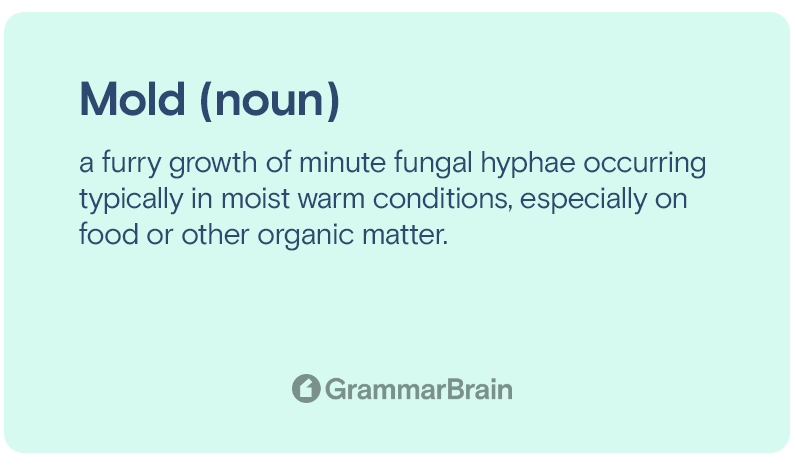Is it mold or mould? Can’t decide between ‘mold on the ceiling’ or ‘mould on the ceiling’ while emailing your landlord? The good news is, you could use either of these words and still be correct!
Difference Between Mold and Mould
The Americans and the British Spell many words differently, and this case is no exception. American English uses only Mold, and U.K English uses only Mould.
Still, both words have multiple meanings, and they can get confusing. In this article, we will learn the various meanings of the words and how to use them in real-life scenarios.
| Word | Spelling |
| Mould | British English |
| Mold | American English |
History of Mold/Mould
According to etymonline.com, mold/mould came from Latin modulum in the 1200s to mean ‘hollow pattern of a particular form by which something is shaped or made’. By 1400s, the word also came to mean ‘minute, furry fungus’ and by 1600s, the word was further used as a verb which describes ‘to mix, blend (something) by kneading’.
Now, to understand how all this is relevant to us, let us see the different meanings of mold in the present day,

The Definition of “Mold”
This word can function both as a verb and a noun depending on the sentence that it’s used in.
A definition of Mold, according to Merriam-webster is ‘a cavity in which a substance is shaped’.
The following examples will help us understand how to use Mold in this context:
- He spends a year making the perfect mold for his designer shoes.
- These are romantic valentine’s day cupcakes made using heart-shaped molds.
Another meaning of mold is a fungus growth on organic matter:
The sentences below describe how to use Mold based on this meaning:
- The house was not selling because of mold on the ceiling.
- The floods caused mold to form on the hardwood floors.
- The pickle was sitting outside for a month and had mold in it’.
Now that we have a clear picture of how to use Mold as a noun, let’s look at its function as a verb.
Mold, as a verb, means to form or shape something. Similarly, another definition of mold by macmillandictionary.com is ‘to influence someone so that they will have certain qualities or behave in a certain way.’ Here we notice that Mold can be used for an object or a person. The following examples will make this concept clear:
- The teacher molds the worldview of her students.
- He molded his anger into self-discipline and drive.
- The artist skillfully molded the metal into a statue.
If all this is not enough, the word mold can be used figuratively as well! The examples below showcase this concept:
- ‘Their approach to sports teaching broke the mold’ -dictionary.com
- She broke the mold, being the first female astronaut.
When to use “mould?”
It depends on where you live or to whom you are communicating! As mentioned earlier, Mold and Mould have the same meanings. As grammarist.com suggests, If you follow U.K English, use Mould (remember, both U.K and Mould have U in them). If you follow American English, use Mold. The only rule is, to pick a spelling and be consistent with it!
Conclusion
The English language has many confusing words, and you are not alone in trying to figure out the correct spellings and meanings of words. Don’t be scared to use the words Mold or Mould in all its derivatives because both are spelled correctly!
Inside this article
Fact checked:
Content is rigorously reviewed by a team of qualified and experienced fact checkers. Fact checkers review articles for factual accuracy, relevance, and timeliness. Learn more.
Core lessons
Glossary
- Abstract Noun
- Accusative Case
- Anecdote
- Antonym
- Active Sentence
- Adverb
- Adjective
- Allegory
- Alliteration
- Adjective Clause
- Adjective Phrase
- Ampersand
- Anastrophe
- Adverbial Clause
- Appositive Phrase
- Clause
- Compound Adjective
- Complex Sentence
- Compound Words
- Compound Predicate
- Common Noun
- Comparative Adjective
- Comparative and Superlative
- Compound Noun
- Compound Subject
- Compound Sentence
- Copular Verb
- Collective Noun
- Colloquialism
- Conciseness
- Consonance
- Conditional
- Concrete Noun
- Conjunction
- Conjugation
- Conditional Sentence
- Comma Splice
- Correlative Conjunction
- Coordinating Conjunction
- Coordinate Adjective
- Cumulative Adjective
- Dative Case
- Determiner
- Declarative Sentence
- Declarative Statement
- Direct Object Pronoun
- Direct Object
- Diction
- Diphthong
- Dangling Modifier
- Demonstrative Pronoun
- Demonstrative Adjective
- Direct Characterization
- Definite Article
- Doublespeak
- False Dilemma Fallacy
- Future Perfect Progressive
- Future Simple
- Future Perfect Continuous
- Future Perfect
- First Conditional
- Irregular Adjective
- Irregular Verb
- Imperative Sentence
- Indefinite Article
- Intransitive Verb
- Introductory Phrase
- Indefinite Pronoun
- Indirect Characterization
- Interrogative Sentence
- Intensive Pronoun
- Inanimate Object
- Indefinite Tense
- Infinitive Phrase
- Interjection
- Intensifier
- Infinitive
- Indicative Mood
- Participle
- Parallelism
- Prepositional Phrase
- Past Simple Tense
- Past Continuous Tense
- Past Perfect Tense
- Past Progressive Tense
- Present Simple Tense
- Present Perfect Tense
- Personal Pronoun
- Personification
- Persuasive Writing
- Parallel Structure
- Phrasal Verb
- Predicate Adjective
- Predicate Nominative
- Phonetic Language
- Plural Noun
- Punctuation
- Punctuation Marks
- Preposition
- Preposition of Place
- Parts of Speech
- Possessive Adjective
- Possessive Determiner
- Possessive Case
- Possessive Noun
- Proper Adjective
- Proper Noun
- Present Participle
- Prefix
- Predicate



